

| Uncooled Infrared (3-16 μm) Quantum Cascade Lasers
Band Structure EngineeringThe quantum cascade laser (QCL) is based on inter-subband electron transitions inside a quantum well structure, which can be tailored to emit different wavelengths simply by changing the thickness of the constituent layers. In other words, we are no longer limited by inherent band gaps, and can demonstrate a very versatile source using one material system. 
Conduction band schematic of GaInAs/AlInAs quantum cascade laser lattice matched to InP Tunable Emission Over a Wide Spectral RangeFor InP-based heterostructures, we have already utilized this principle to show pulsed laser emission from 3.7-16 μm at room temperature 
Demonstrated pulsed laser wavelengths at room temperature Trace and Remote Chemical SensingOne of the primary applications for this laser is as a sensor for toxic chemicals, warfare agents, and explosives. Most chemicals have distinctive absorption lines in the mid- to far-infrared (3-16 μm wavelength), which makes quantitative analysis possible through laser absorption spectroscopy. .jpg)
Example absorption regions in the mid- and far-infrared Lasers can be used to respond to extremely low concentrations of these chemicals, before a danger is present. Multiple wavelengths can be used to filter out interferents and minimize the possibility of false positives. To help preserve the safety of the most people, such devices should be inexpensive and readily available. A self-contained prototype quantum cascade laser pointer realized at CQD is shown. The device shown below is capable of multi-Watt continuous output power at room temperature with only fan cooling (no thermoelectric cooler). 
Photograph of a self-contained prototype quantum cascade laser pointer realized at CQD Mid-Infrared Free-Space Communications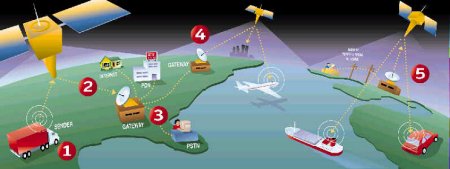
One application for quantum cascade lasers is for use in free-space wireless optical communication networks. Lasers operating in the 3-5 and 8-12 μm wavelength ranges can make use of high atmospheric transmission for long distance applications such as remote chemical sensing, free space optical communication, and laser radar. Because of the long wavelengths these lasers are much less sensitive to bad weather and smoky conditions. Further, room temperature operation allows a more reliable transmitter in a smaller package. By combining high power, long wavelength emission, and room temperature operation into one package, the QCL becomes a clear candidate for realizing a compact, reliable, wireless free-space communications. High Power and High Efficiency Continuous Wave QCLsOne of the main limitations for the quantum cascade laser at higher duty cycles is removal of waste heat. This makes wide cavity designs impractical for high average or continuous output power operation. In the following sections, we detail other mechanisms for improving device output power using narrower ridges that have intrinsically better beam quality. Similar to near-infrared lasers, the CW laser performance can theoretically be enhanced through more sophisticated fabrication and packaging techniques. Using advanced fabrication techniques, such a buried heterostructure QCLs and electoplated Au heat spreaders and epilayer-down bonding of laser dies onto diamond submounts, we have further improved the power and efficiency of CW QCLs dramatically in recent years. 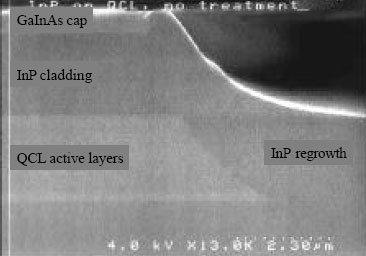 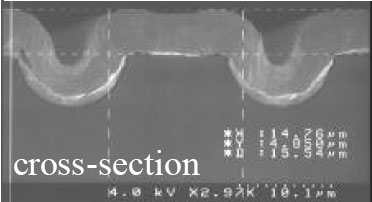
Cross section image of a buried-ridge QCLlaser, left. Cross section image of a Au electroplated QCL, right As mentioned above, wavelength diversity is one of the key advantages of QCL technology. As such, significant effort was dedicated to achieve strong CW performance at both shorter and longer wavelengths than other groups have demonstrated. The CQD is currently the only research group, university or otherwise, to have demonstrated continuous wave (CW) operation of QCLs at room temperature and above with the highest output powers over a broad range of wavelengths from 3.8 μm to 11.5 μm. The figure below represents a summary of our maximum cw output power at room temperature at various wavelengths.  Besides basic packaging, significant effort has also been placed on improving the intrinsic wallplug (power conversion) efficiency of the QCL. After analyzing various sources of inefficiency in our 4.6 μm lasers, several key problems were identified that could be addressed. We are currently tackling these problems and have shown dramatic improvement in our wall plug efficiency. As a highlight of this work, shown below are the power and efficiency characteristics of a buried ridge 4.6 μm laser bonded epilayer-down on a diamond submount. 5 W of continuous power is measured with an power conversion efficiency of 21%, which is a world record (Bai et al., Appl. Phys. Lett. 98, 181102 (2011)). 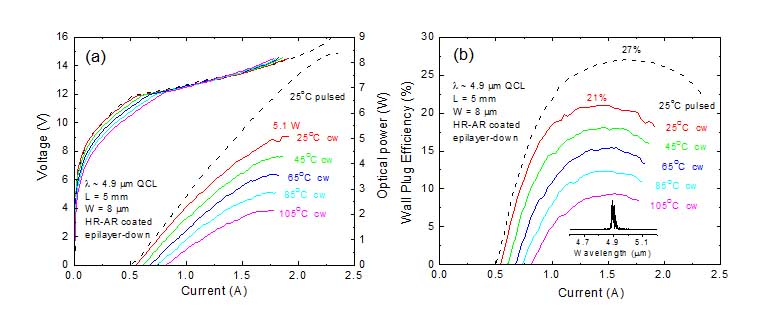 World's Highest Efficiency Cooled Quantum Cascade LaserBeyond room temperature performance, a basic questions remains. What is the highest efficiency we can achieve, when temperature is not a concern? To answer this question, the laser emitting region was redesigned to remove unnecessary energy barriers necessary for higher temperature operation. After fabrciation and testing, we found that the low temperature performance was excellent, with up to 53% wallplug efficiency measured at 40 K. 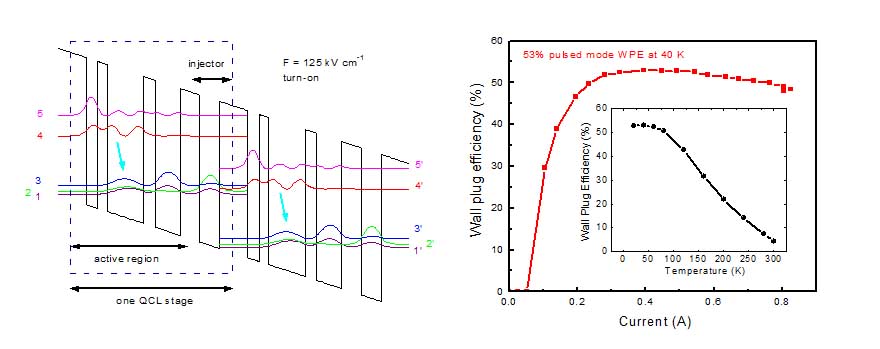
Band structure and efficiency curves for a mid-infrared QCL at cryogenic temperatures (Bai et al., Nature Photonics 4, pp. 99-102 (2010)). High Peak Power QCLs at Room TemperatureAt the Center for Quantum Devices, we have demonstrated high peak power single emitters at room temperature by investigating power scaling. Some of this work is shown in the figure below for shorter wavelength lasers. For pulsed mode operation, the output power is nearly proportional to the ridge width. Above 50 μm we start to see a decreasing of the WPE, however, the efficiency can stay above 12% even for very wide widths. In addition, the far field for wider ridges are distinctively double lobed, which is a signature of a high order transverse mode. Despite the slight reduction in WPE, the maximum total peak power for the 400-μm-ridge-width device still reaches 120 W at room temperature, which can be very attractive for applications that need a high power pulsed source. (Bai et al., Appl. Phys. Lett. 95, 221104 (2009)) 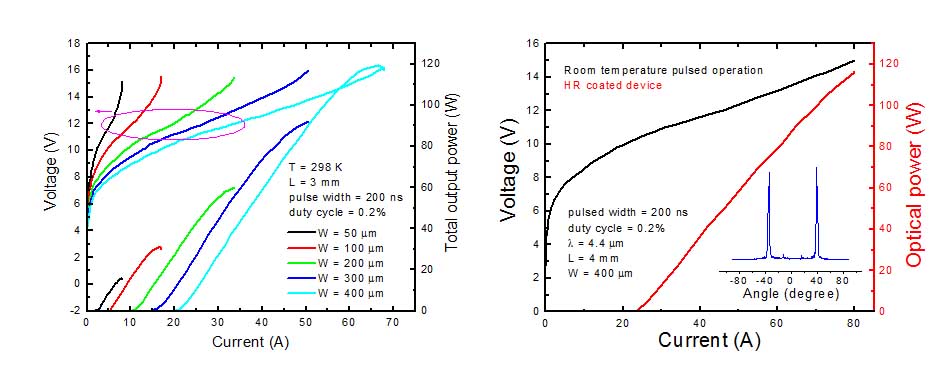
(Left) Room temperature pulsed mode operation of a 4.4 μm QCL with different ridge widths. (Right) Power from front facet of a HR-coated wide ridge laser. Inset shows the far-field, which is stable and does not show signs of filamentation. Similar work has also been done at longer wavelengths. At a 10 μm wavelength, the power was scaled by increasing the number of emitting stages and the core doping level. For a 75-stage emitter and a 95 μm ridge width, up to 25 W of peak power was observed from a single emitter, as shown below. While the output far-field wasn't diffraction-limited, most of the power was in a single spatial lobe. (Razeghi et al. New J. Phys. 11, 125017 (2009)) 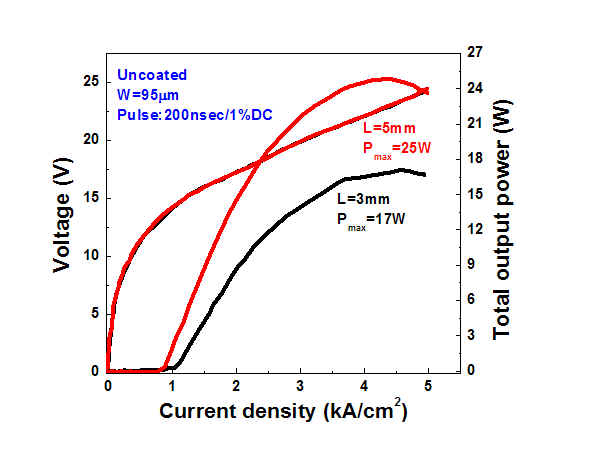
High peak power, room temperature QCL at 10 micron wavelength Distributed Feedback (DFB) Quantum Cascade LasersIn order to show single mode output, CQD researchers have successfully fabricated preliminary distributed feedback quantum cascade lasers (DFBQCLs). This structure uses a diffraction grating either buried within or on top of the ridge waveguide to isolate a single output wavelength. In-house facilities include an electron- beam lithography system and a custom holographic lithography system, which can rapidly fabricate arbitrary grating periods and duty cycles. Isolated gratings and laser ridge examples are shown in the SEM micrographs.  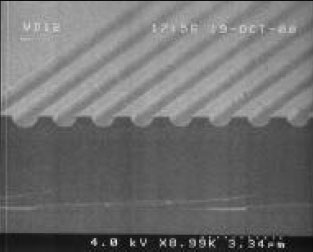 At present, DFB-QCLs emitting at 4.8, 7.8, 9 and 11 μm have been fabricated and tested. Recent advances in power and efficiency have allowed for dramatic improvements in the available output power and true single mode (both longitudinal and transverse) operation. Shown below is a device capable of 2.4 W single mode continuous output at room temperature. (Lu et al., Appl. Phys. Lett., 98, 181106 (2011)) 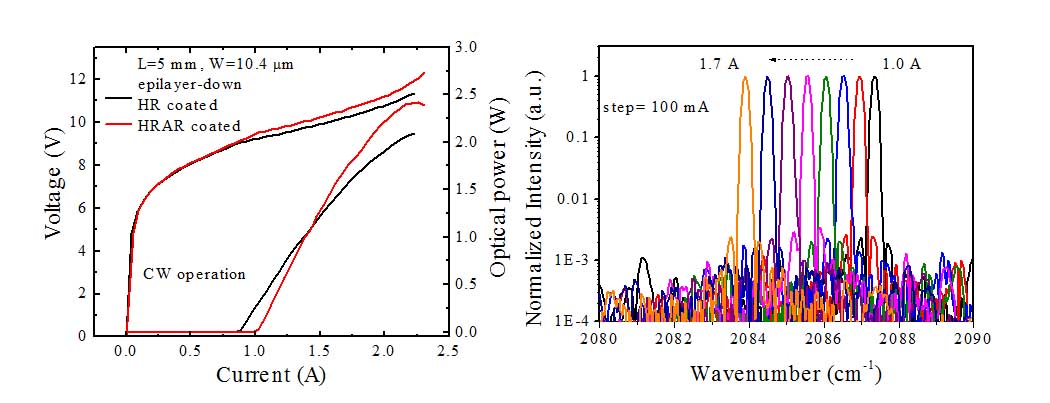 Though work continues to scale the CW single-mode output power, we have also done extensive research into pulsed power scaling with photonic crystal diffractive feedback. By combining a wide laser cavity with a two-dimensonal photonic crystal, the peak output power can still be scaled, but the laser far-field and emitting spectrum can remain single mode. The photonic crystal distributed feedback (PCDFB) QCLs we have demonstrated can start with the same laser core and grating host layer used for standard DFB lasers described above. After the grating layer is patterned with the 2-D photonic crystal structure, the waveguide top cladding are regrown directly on top, burying the diffractive structure within the waveguide for maximum coupling and minimal excess loss. A schematic of the structure is shown below. 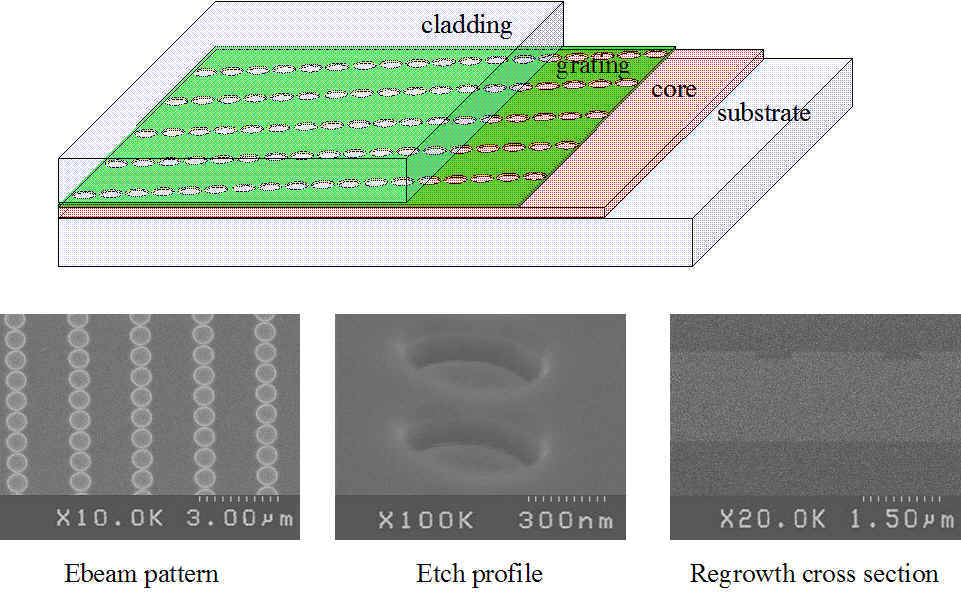 Top: Schematic layer structure of PCDFB QCL. Bottom: Top, oblique, and side view of the PCDFB pattern in PMMA, grating host layer, and finished heterostructure. The figures below show some of our more recent accomplishments. As predicted, the beam quality and spectral purity can be significantly enhanced. Though initial lasers had only a few Watts of power, recent testing has demonstrated, for wavelength near 4.35 μm, peak output powers near 34 W with narrow spectral and near-diffraction-limited far-field behavior. 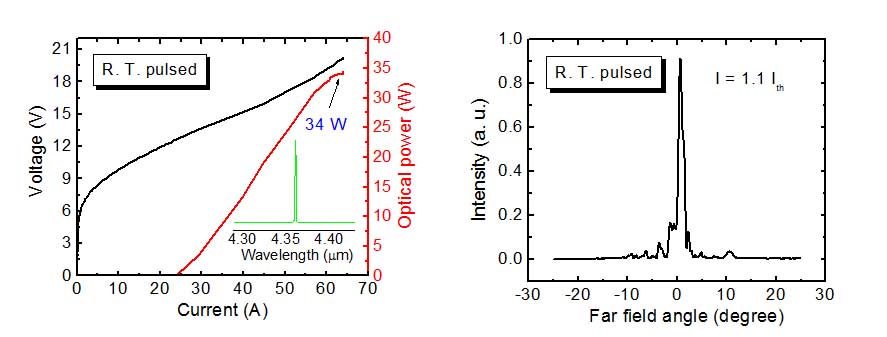
Power, output spectra, and far-field of high peak power PCDFB. (Gokden et al., Appl. Phys. Lett. 97, 131112 (2010)) High Reliability QCLs
|
| © 2020 Center for Quantum Devices, Northwestern University Disclaimer |